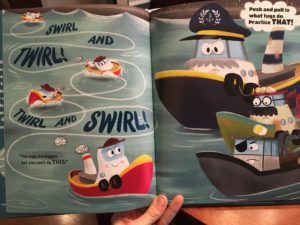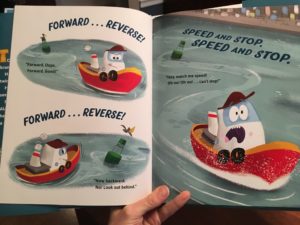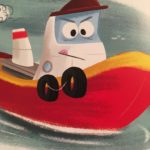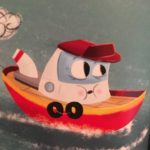 Why I Picked It Up: Every now and then, books come to us. It’s magical when that happens! I tend to stick to the same kinds of books when I’m browsing (creature of habit), so when books come to use, I enjoy the opportunity to expand my horizons! Tough Tug was one that came in the mail from a publisher in exchange for our honest review. It’s due to be released on March 1, 2018 – check it out on Amazon!
Why I Picked It Up: Every now and then, books come to us. It’s magical when that happens! I tend to stick to the same kinds of books when I’m browsing (creature of habit), so when books come to use, I enjoy the opportunity to expand my horizons! Tough Tug was one that came in the mail from a publisher in exchange for our honest review. It’s due to be released on March 1, 2018 – check it out on Amazon!
Why I Finished It: Tough Tug is about a brand new little tugboat who is trying to figure out who he is and how he fits in. It’s a story of identity and belief with a great message for kiddos about being the best you can be and operating in your strengths but also helping those around you.
Tough Tug could almost operate on two different levels for readers and non-readers because of the complexity of the illustrations (more on that later!) and I was really captivated by the characters and the way they were drawn.
Who I Would Give It To: Elementary teachers can all find something to use in Tough Tug. Whether you just want a read aloud with lots of movement or a mentor text for character analysis, this is a fun book!
Integration Ideas
Character
The facial expressions on the boats in Tough Tug are exquisite! So many good character words come to mind as I look at the many faces of Tough Tug! Wow!
For younger students, you could pick one of these pictures to put up on the screen to study as a class. Point out the eyes, the eyebrows, the shape of the mouth, even the smoke stack on the back of the boat, and talk about how they all contribute to the character of Tough Tug in that moment.
For older students, put out a series of pictures like we have above, or one from the beginning, middle, and end of the story, and talk about the way the character changes over the course of the book. In the beginning, Tough Tug is bold and cocky, and by the end he’s confident. Have students discuss what events from the story contributed to his character traits. What events helped him progress from falsely confident to truly confident?
And that’s just one character in this book! Depending on the standards you are responsible for, you could use this to model how characters interact with each other. Tough Tug and Arctic Tug don’t exactly see eye to eye at the beginning. But through the events in the book, they both have a new appreciation for each other by the end!
Levels of Story – verbs and word choice

I LOVE the nuances of text and illustration. I’m not sure if the author and illustrator intended for it to be this way, but there seems to me to be two levels of the story on each page. The words in big, bold, teal font are also big, bold, movement words. As I was reading, I realized that these bold words, in conjunction with the illustrations, can tell the story on their own. It almost feels like a board book in the simplicity of the words. When I read to younger students, less is more! For my 2- and 3-year olds, I read the bold words, talk about the picture (or just let them absorb) and then move on.
For my older and more kinesthetic students, I have them study the movement/action verbs and point out what they mean by looking at the pictures. Then, I read the story a second time and this time, since they know the meanings of the words, the students move (within their space) the way the verb is dictating.

After studying the verbs like this, move it into their writing! When the students go to writing center or participate in Writers’ Workshop, have the students use these strong verbs. If they are writing a story about going to the beach, how did the waves move? If they are playing baseball, how did they swing the bat? Make sure that the students add a great picture that shows emotion!
You could also read the words in the black text to add more information for older listeners. It’s more dialogue and adds more detail to the characters. Or you could do a bit of both!
Maps
The end papers of Tough Tug show a simple map of Tough Tug’s journey from Anacortes, WA, where he was built, to Anchorage, AK. The map is a great illustration, but for kiddos who likely haven’t traveled outside of their home city, it doesn’t provide much context for Tug’s journey. To Google Maps!
Research
There is a tiny Author’s Note on the last page of the book, on the same page as the special thanks and copyright info, that Tough Tug is based on a true incident. You know what that means…RESEARCH!
General Tug Information: http://www.tugboatenthusiastsociety.org/Pages/tugs.htm
https://www.mcallistertowing.com/AboutMcAllister/History.aspx
Though I couldn’t find information on the original incident, there are lots of stories about tugboats you could use to pair with this book, like this one:









Thanks for this helpful post. I’m a former early ed teacher so I love how you employ the various features and attributes of what looks to be a great book!
Thank you, Carrie! I think our biggest problem is that there are so many great books out there, we can’t stop shopping!
I love that you “got” the bi-level text. Yes, toddlers are fine with just the action verbs. Older kids love to hear Tug’s comments on the trip.
Thanks for your excellent classroom connection suggestions! Hope Tough Tug delights many classrooms!
You’re welcome! We have heard many positive comments about teachers excited to use Tough Tug in their classroom!